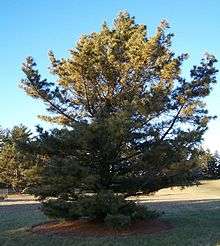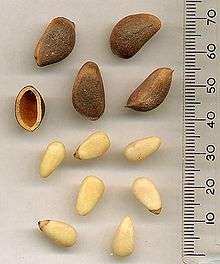Pinus koraiensis
| Pinus koraiensis | |
|---|---|
 | |
| Morton Arboretum Acc. 748-56*2 | |
| Scientific classification | |
| Kingdom: | Plantae |
| Division: | Pinophyta |
| Class: | Pinopsida |
| Order: | Pinales |
| Family: | Pinaceae |
| Genus: | Pinus |
| Subgenus: | Strobus |
| Section: | Pinus sect. Quinquefoliae |
| Subsection: | Pinus subsect. Cembrae |
| Species: | P. koraiensis |
| Binomial name | |
| Pinus koraiensis Siebold & Zucc. | |
The tree species Pinus koraiensis is commonly called Korean pine. It is native to eastern Asia: Korea, Manchuria, Mongolia, the Temperate rainforests of the Russian Far East, and central Japan. In the north of its range, it grows at moderate altitudes, typically 600 metres (2,000 ft) to 900 metres (3,000 ft), whereas further south, it is a mountain tree, growing at 2,000 metres (6,600 ft) to 2,600 metres (8,500 ft) altitude in Japan. It is a large tree, reaching a mature size of 40 metres (130 ft) to 50 metres (160 ft) height, and 1.5 metres (4.9 ft) to 2 metres (6.6 ft) trunk diameter.
It is a member of the white pine group, Pinus subgenus Strobus, and like all members of that group, the leaves ('needles') are in fascicles (bundles) of five, with a deciduous sheath. They are 7 centimetres (2.8 in) to 13 centimetres (5.1 in) long. Korean pine cones are 8 centimetres (3.1 in) to 17 centimetres (6.7 in) long, green or purple before maturity, ripening brown about 18 months after pollination. The 14 millimetres (0.55 in) to 18 millimetres (0.71 in) long seeds have only a vestigial wing and are dispersed by spotted nutcrackers.

Korean pine differs from the closely related Siberian pine in having larger cones with reflexed scale tips, and longer needles.
The seeds are extensively harvested and sold as pine nuts, particularly in northeastern China; it is the most widely traded pine nut in international commerce. The nut oil contains 11.5% of the unusual fatty acid pinolenic acid (cis–5–cis–9–cis–12 octadecatrienoic acid).[1]
Korean pine is a popular ornamental tree in parks and large gardens where the climate is cold, such as eastern Canada and the far northern United States, giving steady though not fast growth on a wide range of sites. It is tolerant of severe winter cold, hardy down to at about −50 °C (−58 °F).
See also
- Boreal forest
- Jatjuk, Korean pine nut porridge
References
- ↑ Imbs, Nevshupova, and Pham: "Triacylglycerol Composition of Pinus koraiensis Seed Oil" JAOCS 75(7)865—870. 1998, AOCS Press.
Further reading
- Conifer Specialist Group (1998). "Pinus koraiensis". IUCN Red List of Threatened Species. Version 2006. International Union for Conservation of Nature. Retrieved 5 May 2006.
- Das, A. K. Studies on the growth pattern, primary productivity and nutrient dynamics of Khasi pine (Pinus kesiya Royal ex Gordan). Diss. Ph. D. thesis, North Eastern Hill University, Shillong, India, 1980.
External links
| External identifiers for Pinus koraiensis | |
|---|---|
| Encyclopedia of Life | 999709 |
| NCBI | 88728 |
| Also found in: Wikispecies | |
- USDA NRCS Plant Profile Pinus koraiensis
- USDA, ARS, National Genetic Resources Program
- Organics Roots
- Pinus Koraiensis (Korean Pine)_Only Foods
- Conifers Around the World: Pinus koraiensis - Korean Stone Pine
| Wikimedia Commons has media related to Pinus koraiensis. |
